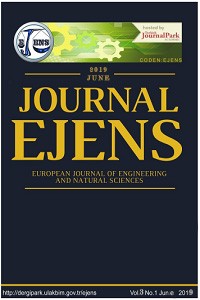Öz
Aseptic
loosening is a common problem in total hip replacement surgery. Routine
radiological imaging techniques are used for postoperative diagnosis. The
alternative technique is required to develop because of the low success rate in
current diagnostic techniques. The purpose of this study is to develop the new
method to diagnose the aseptic loosening of the stem using vibration technique.
Two different experimental setups were established in this study, vibrational
and cyclic loading tests. In the vibrational test, the bone-prosthetic models
were vibrated from the distal femur at a certain frequency and then the
vibration data were taken via accelerometer from the trochanter region of the
femur. The vibration data were converted to the frequency domain for
evaluations. The stability of the femur-prosthesis system was determined by
evaluating the fundamental frequency change and harmonics generated at the FFT
analysis. In the cyclic loading test, the femur-prosthesis system was forced to
fatigue at a maximum amplitude of 1700 N and 1 Hz frequency. After every 5000
cycles in the test, the femoral prosthesis system was connected to the
vibrational test and the loosening of the system was considered. After 115000 cycles,
the harmonic frequencies were observed and the amplitude value of the
fundamental frequency was decreased. The experiments were stopped when the stem
was pulled out easily from the femur. As the degree of the loosening increased,
the number of the harmonics increased and the fundamental frequency values
decreased. In conclusion, the vibration method can be used as an alternative
technique to determine the degree of the hip stem loosening.
Anahtar Kelimeler
Aseptic loosening Total Hip Prosthesis Vibration Technique Cyclic Loading
Kaynakça
- [1]. H. Malchau, P. Herberts, T. Eisler, G. Garellick, and P. Soderman, "The Swedish Total Hip Replacement Register " J. Bone Joint Surg. Am., vol. 86-A, pp. 2-20, 2002.
- [2]. K. E. Dreinhofer, "Indications for total hip replacement: comparison of assessments of orthopaedic surgeons and referring physicians," Annals of the Rheumatic Diseases, vol. 65, pp. 1346-1350, 2006.
- [3]. A. P. Georgiou and J. L. Cunningham, "Accurate diagnosis of hip prosthesis loosening using a vibrational technique," Clinical Biomechanics, vol. 16, pp. 315-323, 2001.
- [4]. L. C. Pastrav, S. V. N. Jaecques, I. Jonkers, G. Perre, and M. Mulier, "In vivo evaluation of a vibration analysis technique for the per-operative monitoring of the fixation of hip prostheses," Journal of Orthopaedic Surgery and Research, vol. 4, p. 10, 2009.
- [5]. J. S. Rieger, S. Jaeger, C. Schuld, J. P. Kretzer, and R. G. Bitsch, "A vibrational technique for diagnosing loosened total hip endoprostheses: An experimental sawbone study," Medical Engineering & Physics, vol. 35, pp. 329-337, 2013.
- [6]. A. A. Alshuhri, T. P. Holsgrove, A. W. Miles, and J. L. Cunningham, "Development of a non-invasive diagnostic technique for acetabular component loosening in total hip replacements," Medical Engineering & Physics, vol. 37, pp. 739-745, 2015.
Öz
Kaynakça
- [1]. H. Malchau, P. Herberts, T. Eisler, G. Garellick, and P. Soderman, "The Swedish Total Hip Replacement Register " J. Bone Joint Surg. Am., vol. 86-A, pp. 2-20, 2002.
- [2]. K. E. Dreinhofer, "Indications for total hip replacement: comparison of assessments of orthopaedic surgeons and referring physicians," Annals of the Rheumatic Diseases, vol. 65, pp. 1346-1350, 2006.
- [3]. A. P. Georgiou and J. L. Cunningham, "Accurate diagnosis of hip prosthesis loosening using a vibrational technique," Clinical Biomechanics, vol. 16, pp. 315-323, 2001.
- [4]. L. C. Pastrav, S. V. N. Jaecques, I. Jonkers, G. Perre, and M. Mulier, "In vivo evaluation of a vibration analysis technique for the per-operative monitoring of the fixation of hip prostheses," Journal of Orthopaedic Surgery and Research, vol. 4, p. 10, 2009.
- [5]. J. S. Rieger, S. Jaeger, C. Schuld, J. P. Kretzer, and R. G. Bitsch, "A vibrational technique for diagnosing loosened total hip endoprostheses: An experimental sawbone study," Medical Engineering & Physics, vol. 35, pp. 329-337, 2013.
- [6]. A. A. Alshuhri, T. P. Holsgrove, A. W. Miles, and J. L. Cunningham, "Development of a non-invasive diagnostic technique for acetabular component loosening in total hip replacements," Medical Engineering & Physics, vol. 37, pp. 739-745, 2015.
Ayrıntılar
| Birincil Dil | İngilizce |
|---|---|
| Konular | Mühendislik |
| Bölüm | Makaleler |
| Yazarlar | |
| Yayımlanma Tarihi | 27 Haziran 2019 |
| Yayımlandığı Sayı | Yıl 2019 Cilt: 3 Sayı: 1 |

